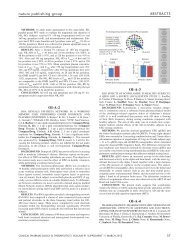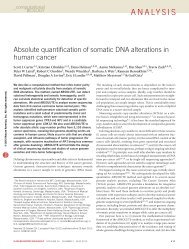open access: Nature Reviews: Key Advances in Medicine
open access: Nature Reviews: Key Advances in Medicine
open access: Nature Reviews: Key Advances in Medicine
You also want an ePaper? Increase the reach of your titles
YUMPU automatically turns print PDFs into web optimized ePapers that Google loves.
(ADPKD) detach from renal tubules and<br />
grow as bl<strong>in</strong>d sacs by a process that requires<br />
cell prolifera tion, net fluid secretion and<br />
remodel<strong>in</strong>g of extracellular matrix. After the<br />
PKD1 and PKD2 genes and their encoded<br />
prote<strong>in</strong>s, polycyst<strong>in</strong>-1 and polycyst<strong>in</strong>-2,<br />
were identified <strong>in</strong> 1994 and 1996, respectively,<br />
research <strong>in</strong> this area greatly accelerated.<br />
In the follow<strong>in</strong>g years, genes mutated<br />
<strong>in</strong> autosomal recessive PKD (PKHD1 encod<strong>in</strong>g<br />
fibro cyst<strong>in</strong>) and <strong>in</strong> autosomal dom<strong>in</strong>ant<br />
polycystic liver disease (PRKCSH encod<strong>in</strong>g<br />
glucosidase 2 subunit β, and SEC63 encod<strong>in</strong>g<br />
translocation prote<strong>in</strong> SEC63 homolog)<br />
were identified. Polycyst<strong>in</strong>-1, polycyst<strong>in</strong>-2<br />
and fibrocyst<strong>in</strong> are membrane glyco prote<strong>in</strong>s,<br />
whereas glucosidase 2 subunit β and SEC63<br />
are endoplasmic reticulum resident prote<strong>in</strong>s<br />
needed for translocation and fold<strong>in</strong>g<br />
of <strong>in</strong>tegral membrane prote<strong>in</strong>s and secreted<br />
prote<strong>in</strong>s. Polycyst<strong>in</strong>-1, polycyst<strong>in</strong>-2 and<br />
fibrocyst<strong>in</strong> have numerous <strong>in</strong>teract<strong>in</strong>g partners<br />
and their disruption affects multiple<br />
signal<strong>in</strong>g pathways. Despite the multi plicity<br />
of genes and signal<strong>in</strong>g pathways <strong>in</strong>volved <strong>in</strong><br />
PKD, <strong>in</strong>terventions affect<strong>in</strong>g many diverse<br />
targets have been effective <strong>in</strong> animal models<br />
of PKD, which <strong>in</strong>dicates the presence of<br />
connections between the various pathways.<br />
Understand<strong>in</strong>g these complex <strong>in</strong>teractions<br />
will be essential to effectively treat PKD.<br />
Fedeles et al. used mouse mutants to<br />
show that the ma<strong>in</strong> prote<strong>in</strong>s implicated <strong>in</strong><br />
ADPKD, autosomal recessive PKD and<br />
autosomal dom<strong>in</strong>ant polycystic liver disease<br />
functionally <strong>in</strong>teract. 1 Loss of gluco sidase 2<br />
subunit β or SEC63 reduces polycyst<strong>in</strong>-1<br />
and, to a lesser extent, polycyst<strong>in</strong>-2 expression,<br />
blocks polycyst<strong>in</strong>-1 traffick<strong>in</strong>g to<br />
primary cilia, causes renal and hepatic cysts,<br />
worsens cystic disease <strong>in</strong> hetero zygous<br />
Pkd1 +/− and Pkd2 +/− mice and <strong>in</strong>duces<br />
renal cystogenesis <strong>in</strong> Pkhd1 del4/del4 mice.<br />
Transgenic overexpression of poly cyst<strong>in</strong>-1,<br />
but not polycyst<strong>in</strong>- 2, rescues the renal and<br />
hepatic pheno type of tissue- selective Prkcshknockout<br />
or Sec63-knockout mice and<br />
the renal phenotype of Pkhd1 del4/del4 mice.<br />
Polycyst<strong>in</strong>-1 is the rate-limit<strong>in</strong>g component<br />
<strong>in</strong> the polycyst<strong>in</strong>-1/poly cyst<strong>in</strong>-2 complex as<br />
its level of expression determ<strong>in</strong>es the severity<br />
of the cystic pheno type, but some functional<br />
polycyst<strong>in</strong>-2 is essential for polycyst<strong>in</strong>-1<br />
to exert this effect. Immunocytochemical<br />
analysis revealed that the collect<strong>in</strong>g duct is<br />
the segment most susceptible to the cystogenic<br />
effect of reduced polycyst<strong>in</strong>-1 dosage.<br />
Proteasome <strong>in</strong>hibition <strong>in</strong>creases poly cyst<strong>in</strong>-1<br />
levels and attenuates cystic disease <strong>in</strong> Prkcshknockout<br />
models, thus offer<strong>in</strong>g a conceptual<br />
<strong>Key</strong> advances<br />
■ The ma<strong>in</strong> prote<strong>in</strong>s implicated <strong>in</strong> polycystic<br />
kidney disease (PKD)—polycyst<strong>in</strong>-1,<br />
polycyst<strong>in</strong>-2 and fibrocyst<strong>in</strong>—and <strong>in</strong><br />
autosomal dom<strong>in</strong>ant polycystic liver<br />
disease (glucosidase 2 subunit β and<br />
SEC63) functionally <strong>in</strong>teract 1<br />
■ The vasopress<strong>in</strong> V2 receptor antagonist,<br />
tolvaptan, <strong>in</strong>hibits cystogenesis <strong>in</strong> vitro, 2<br />
and reduced the volume of polycystic<br />
kidneys after 1 week of treatment, and<br />
slowed the growth of polycystic kidneys<br />
<strong>in</strong> a 3-year, <strong>open</strong>-label study of patients<br />
with PKD 3<br />
■ Two <strong>in</strong>sul<strong>in</strong>-sensitiz<strong>in</strong>g drugs used to<br />
treat type 2 diabetes mellitus, metform<strong>in</strong><br />
and a peroxisome proliferator-activated<br />
receptor-γ agonist, <strong>in</strong>hibit cyst growth <strong>in</strong><br />
rodent models of PKD by different and<br />
possibly complementary mechanisms 4–6<br />
■ Macrophage <strong>in</strong>filtration contributes to the<br />
proliferation of cyst-l<strong>in</strong><strong>in</strong>g cells and PKD<br />
progression 7<br />
■ STAT3, a transcription factor that is<br />
essential dur<strong>in</strong>g development but<br />
dispensable postnatally, is a novel<br />
therapeutic target <strong>in</strong> PKD 8–10<br />
therapeutic approach to auto somal dom<strong>in</strong>ant<br />
polycystic liver disease and possibly ADPKD.<br />
The central role of cyclic AMP <strong>in</strong> PKD,<br />
and the ability to hormonally modulate<br />
cyclic AMP <strong>in</strong> a cell-specific manner,<br />
enables target<strong>in</strong>g of an important cystogenic<br />
pathway with relative safety. Among<br />
hormonal systems that affect renal cyclic<br />
AMP is the vasopress<strong>in</strong>–V2 receptor axis.<br />
This target is attractive because V2 receptors<br />
are mostly restricted to the thick<br />
ascend<strong>in</strong>g limb and collect<strong>in</strong>g ducts, which<br />
are ma<strong>in</strong> sites of cystogenesis where vasopress<strong>in</strong><br />
is the major agonist of cyclic AMP.<br />
These sites are cont<strong>in</strong>uously subjected to<br />
tonic vaso press<strong>in</strong> action. Circulat<strong>in</strong>g vasopress<strong>in</strong><br />
levels are <strong>in</strong>creased <strong>in</strong> ADPKD and<br />
V2 receptors are overexpressed <strong>in</strong> polycystic<br />
kidneys. Pharmacological and genetic<br />
<strong>in</strong>hibition of vasopress<strong>in</strong> or V2 receptor<br />
expression has been shown to be effective<br />
<strong>in</strong> rodents. Reif et al. exam<strong>in</strong>ed the effects of<br />
tolvaptan on human ADPKD cyst epithelial<br />
cells. 2 Low concentrations <strong>in</strong>hibited vasopress<strong>in</strong>-<strong>in</strong>duced<br />
cyclic AMP production,<br />
cell prolifera tion, chloride secretion and cyst<br />
growth <strong>in</strong> collagen matrices. Other analyses<br />
showed that tolvaptan adm<strong>in</strong>istration for<br />
1 week reduced total kidney volume by 3.1%<br />
<strong>in</strong> patients with ADPKD, and that 3 years of<br />
tolvaptan therapy reduced kidney growth<br />
by 70% compared to historical controls<br />
(1.7% versus 5.8% <strong>in</strong>crease per year, respectively).<br />
3 Changes <strong>in</strong> kidney volume and <strong>in</strong><br />
NEPHROLOGY<br />
estimated glomerular filtration rate were<br />
significantly and negatively correlated. This<br />
f<strong>in</strong>d<strong>in</strong>g supports the use of kidney volume<br />
as a biomarker to monitor ADPKD progression.<br />
Further evaluation of tolvaptan for the<br />
treatment of patients with ADPKD awaits the<br />
conclusion of a randomized, double-bl<strong>in</strong>d<br />
cl<strong>in</strong>ical trial (NCT00428948) <strong>in</strong> 2012.<br />
Metform<strong>in</strong> and peroxisome proliferatoractivated<br />
receptor (PPAR)-γ agonists are<br />
widely used to treat type 2 diabetes melli tus.<br />
Takiar et al. found that metform<strong>in</strong> stimulates<br />
the energy-sens<strong>in</strong>g molecule AMP-activated<br />
prote<strong>in</strong> k<strong>in</strong>ase (AMPK), <strong>in</strong>hibits the activities<br />
of AMPK-dependent cystic fibrosis transmembrane<br />
conductance regulator (CFTR)<br />
and mammalian target of rapamyc<strong>in</strong> <strong>in</strong><br />
Mad<strong>in</strong>–Darby can<strong>in</strong>e kidney renal epithelial<br />
cells, and attenuates cyclic AMP-dependent<br />
growth of Mad<strong>in</strong>–Darby can<strong>in</strong>e kidney cysts<br />
<strong>in</strong> collagen matrices and of cysts <strong>in</strong> metanephric<br />
organ explants, and cystogenesis <strong>in</strong><br />
constitutive and <strong>in</strong>ducible Pkd1-knockout<br />
mice. 4 Yoshihara et al. and Blazer-Yost et al.<br />
found that the PPAR-γ agonist pioglitazone<br />
<strong>in</strong>hibits renal and hepatic cystogenesis <strong>in</strong><br />
PCK rats by possibly complementary mechanisms<br />
through the <strong>in</strong>activation of mitogen-<br />
activated prote<strong>in</strong> k<strong>in</strong>ase 3 and mammalian<br />
target of rapa myc<strong>in</strong>, 5 and <strong>in</strong>hibition of CFTR<br />
synthesis and cyclic AMP-activated chloride<br />
secretion. 6 Because metform<strong>in</strong> and PPAR-γ<br />
agonists exert salutary effects by affect<strong>in</strong>g the<br />
same pathways through different mechanisms<br />
(such as phosphoryla tion and <strong>in</strong>hibition of<br />
CFTR by metform<strong>in</strong> and <strong>in</strong>hibi tion of CFTR<br />
synthesis by pioglitazone), cl<strong>in</strong>ical trials of<br />
metform<strong>in</strong> and PPAR-γ agonist comb<strong>in</strong>ations<br />
<strong>in</strong> early ADPKD should be considered<br />
to exploit their possible synergism.<br />
Evidence accumulated over the past<br />
two decades po<strong>in</strong>ts to the importance of<br />
<strong>in</strong>flamma tion <strong>in</strong> PKD. Karihaloo et al.<br />
hypothesized that macrophage <strong>in</strong>filtration<br />
contributes to the proliferation of cyst-l<strong>in</strong><strong>in</strong>g<br />
cells and PKD progression. 7 This premise<br />
was based on work show<strong>in</strong>g that macrophages<br />
hom<strong>in</strong>g to the kidney after ischemia–<br />
reperfusion undergo a transition from<br />
classically activated, pro <strong>in</strong>flammatory cells<br />
to alternatively activated cells that promote<br />
epithelial cell proliferation. The <strong>in</strong>vestigators<br />
found that Pkd1-null cells secrete<br />
large amounts of the macrophage chemoattractant<br />
C-C motif chemok<strong>in</strong>e 2 (also<br />
known as monocyte chemotactic prote<strong>in</strong> 1)<br />
and C-X-C motif chemok<strong>in</strong>e 16. Kidneys<br />
from conditional Pkd1-knockout mice<br />
and the Pkd2 WS25/– mouse model of PKD2<br />
exhibit a 10-fold <strong>in</strong>crease <strong>in</strong> the number of<br />
KEY ADVANCES IN MEDICINE JANUARY 2012 | S45








